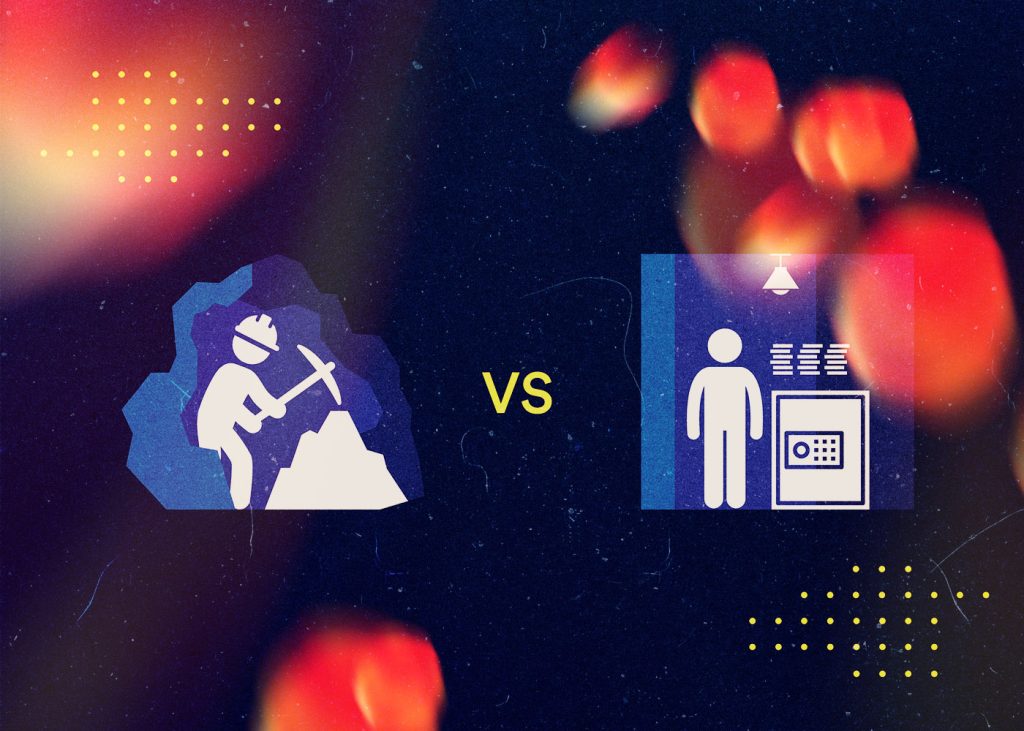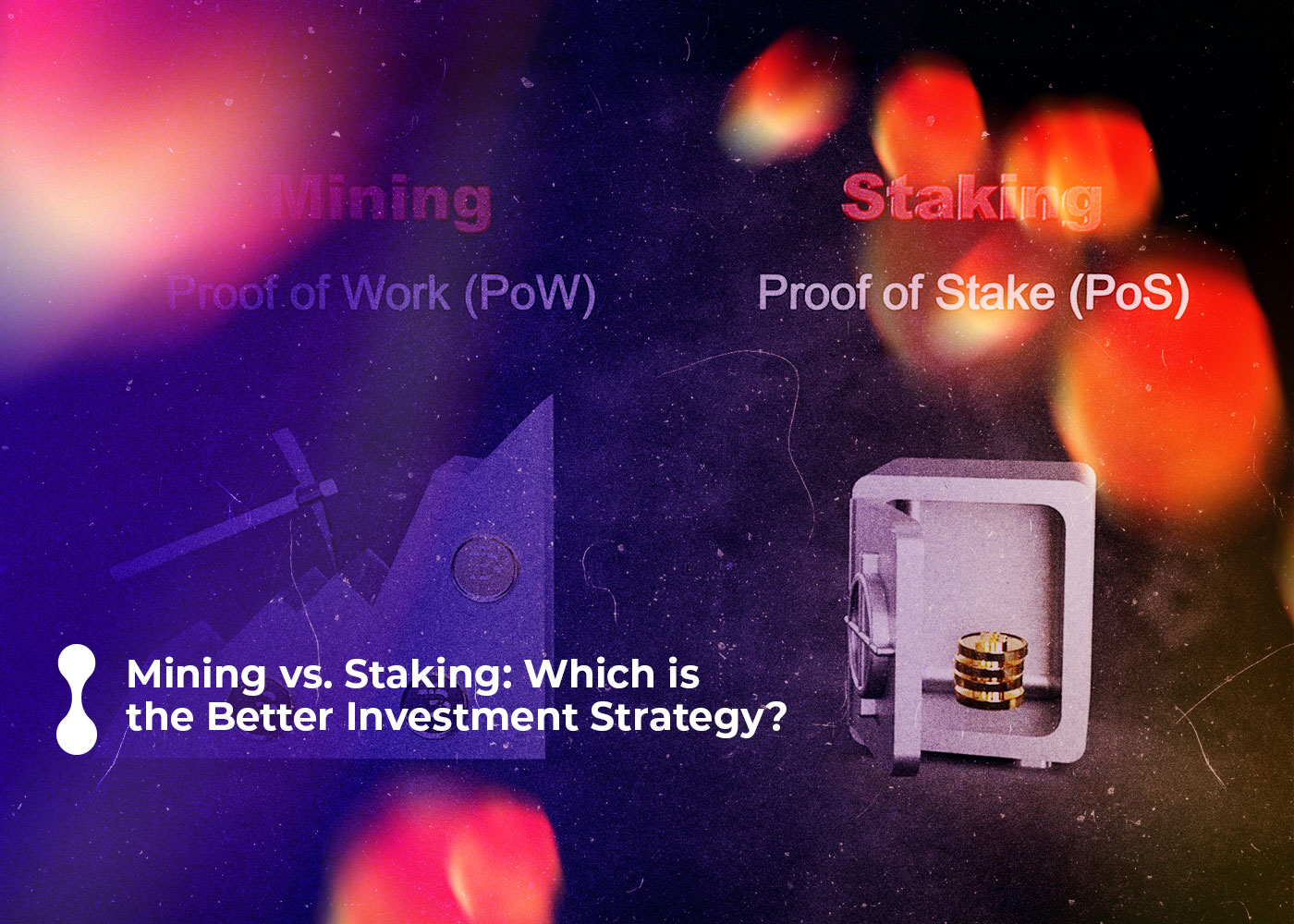Cryptocurrency investment has gained popularity in recent years, with blockchain technology changing how we think about money and finance. Two popular ways of earning digital coins are mining and staking. The mining vs. staking debate is one that has been ongoing in the cryptocurrency world. Mining involves using specialized hardware to validate transactions and solve complex mathematical problems on the blockchain. At the same time, staking requires investors to hold and lock a certain amount of cryptocurrency in a wallet to support the network. In this article, we’ll compare mining vs. staking and explore which method is the better investment strategy.
Let’s Start With the Basics: What Are Mining and Staking?
Mining and staking are two methods for earning cryptocurrency in the blockchain world.
Mining:
Mining is a resource-intensive process that utilizes specialized hardware, such as GPUs, to validate transactions on the blockchain and add new blocks. This requires high computing power and substantial energy consumption, with rewards for miners dependent upon various factors, including the number of participants, in addition to the difficulty level of computations being solved.
Staking:
Unlike mining, staking is an energy-saving and cost-effective approach to validating transactions and adding new blocks to the blockchain. To do this, you must ‘stake’ a certain amount of cryptocurrency in your wallet. This strengthens decentralization within the network and offers more reliable rewards than those obtained through traditional mining methods with less electricity consumption – rendering it an ideal option for long-term crypto investors!
To wrap up, mining vs. staking remains a contentious topic within the cryptocurrency community. The two options present distinct pros and cons depending on one’s objectives and access to funds. Here are some of these potential benefits or drawbacks to consider before you decide which method is best for you.

Advantages and Disadvantages of Mining and Staking:
Evaluating the merits of mining vs. staking is a fascinating conundrum, and people should be armed with an understanding of each option’s pros and cons before making their choice. Here are some relevant benefits and drawbacks associated with both approaches:
Advantages of Mining:
- Mining is often much more lucrative than staking, particularly during times of high cryptocurrency demand.
- Miners have a higher degree of authority over the process, as they can change the hash rate and select which transactions to authenticate.
- Mining is a decidedly discreet activity, as miners are not mandated to reveal their identity.
Disadvantages of Mining:
- Mining is an incredibly energy-hungry operation, requiring strong computing resources and extensive electricity usage.
- Mining hardware can be costly, making it an inaccessible option for some.
- The mining industry is intensely competitive, as there are only a finite number of block rewards readily available.
Advantages of Staking:
- Compared to mining, staking is often viewed as a more energy-efficient and cost-effective approach.
- By offering staking rewards, investors can benefit from increased stability and reliability over the long term, making it a desirable option.
- By staking, you are playing an active role in protecting the decentralization and security of a network.
Disadvantages of Staking:
- Generating lucrative rewards through staking can seem quite appealing to investors. However, it entails locking away their resources for a prolonged period of time with limited liquidity.
- For those who choose to stake their cryptocurrency, the rewards are generally lower than for miners – especially when demand is high.
- When staking cryptocurrency, there is always the danger of slashing–where a portion of one’s tokens are taken away if particular network regulations aren’t followed.
Mining vs. Staking: Which Is Better?
When it comes to mining and staking different cryptocurrencies, the benefits and drawbacks can differ depending on the currency in question, as well as one’s own goals and resources.
When deciding whether to mine or stake your cryptocurrency, bear in mind that the ideal approach is dependent on a range of components, such as your individual targets and resources, the cryptocurrency you are mining/staking, and current market conditions.
Investors who have access to specialized hardware and are seeking higher potential returns should look into mining. Despite its resource-intensive process that necessitates high energy consumption, it may be the right choice for some. It is important to note, though, that this market can be extremely competitive, with limited block rewards available.
Staking is typically seen as a more energy-efficient solution than mining since it does not need any particular hardware and fewer resources. What’s more, the rewards of staking are usually constant and foreseeable, which makes it an attractive choice for continuous investors. Additionally, staking aids in decentralizing the network while boosting its security. Despite these advantages, there can be some risks involved in terms of slashing that could limit private liquidity if one needs to stash away their cryptocurrency during this process.
Ultimately, the choice of staking or mining is a decision that ought to be made based on one’s goals and capability, as well as the crypto being contemplated. Both techniques have their own benefits and drawbacks. Thus, investors should judiciously assess these elements before settling on which method best fits into their investment plan.
Final Words:
To sum up, the decision when it comes to the mining vs. staking debate relies on a person’s objectives, resources available to them, as well as the particular cryptocurrency. Mining might be more remunerative in theory, yet it is an energy-consuming process that necessitates sophisticated hardware. In comparison, staking is ecology-friendly and cost-efficient – encouraging decentralization and network protection – but carries slashing risks that may limit one’s liquidity options down the road.
Before investors make a decision on whether to mine or stake, they should carefully consider the advantages and disadvantages of each option in light of their personal goals and resources. Additionally, it is advantageous to keep tabs on current market conditions and network activity related to the specific coin being considered. By devising a sound mining vs. staking plan that takes into account all these variables, investors can be sure that they are optimizing their investment strategy for maximum returns.
